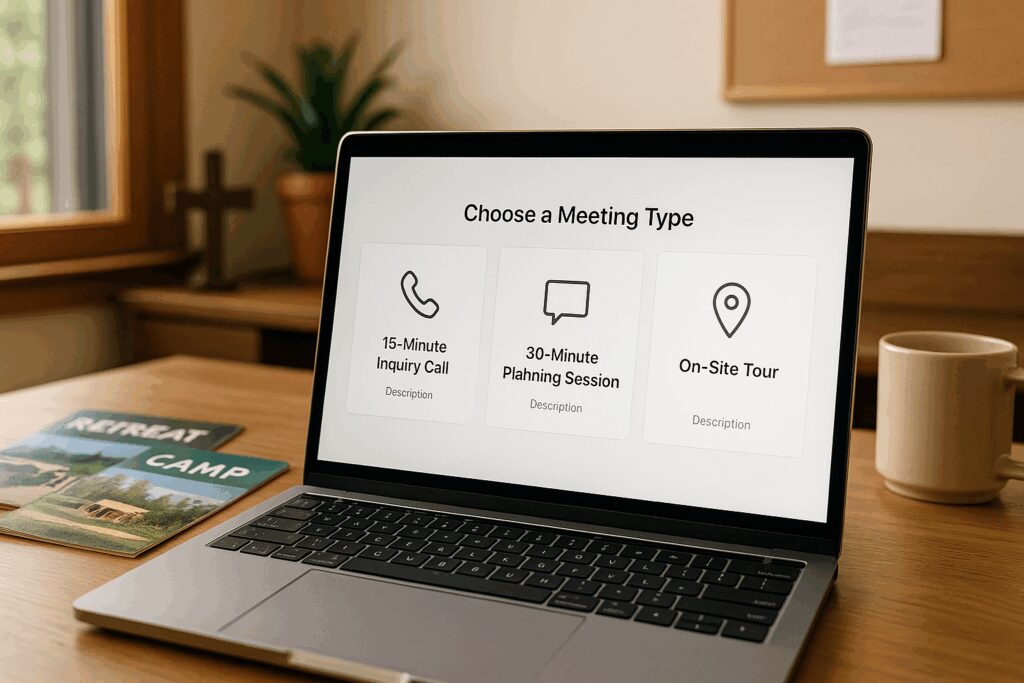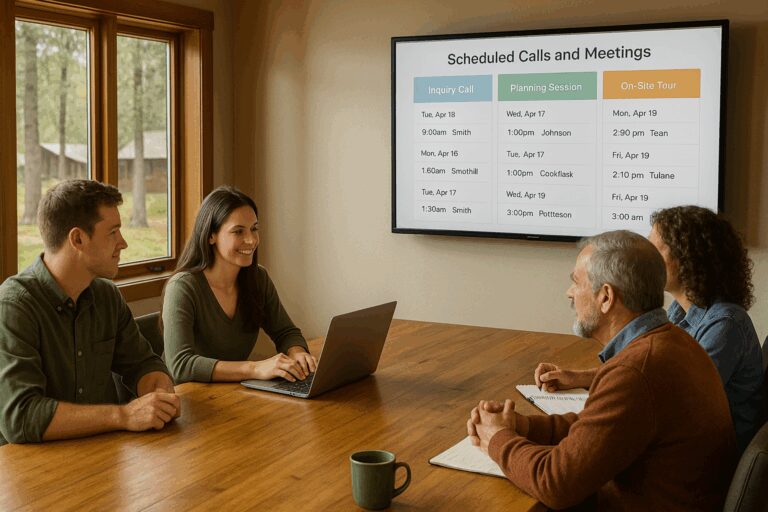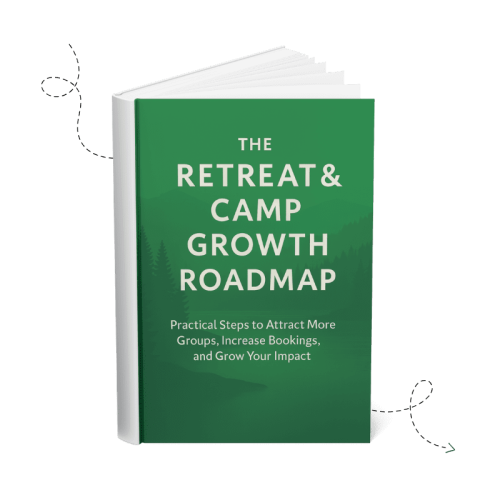Retreat & Camp Growth Roadmap Focus Area: Automate Meeting Scheduling
Introduction
Few things stall momentum with a potential guest faster than the back-and-forth of trying to find a meeting time. Every extra email is a chance for someone to lose interest or forget to reply. Online scheduling tools fix this problem by letting retreat planners pick a time instantly, while protecting your staff’s availability.
Automating this step creates a smoother experience for prospects, reduces wasted staff time, and helps more meetings actually happen. For retreat centers, that means more conversations turning into bookings.
Why This Focus Area Matters
When someone is ready to connect, you want to make it as easy as possible. Manual scheduling consumes staff time and risks losing opportunities. An automated system simplifies the process, shows respect for the guest’s time, and strengthens your ability to follow through.
The benefits go beyond convenience. Automated confirmations and reminders reduce no-shows. Calendar invites keep everything in one place. Rescheduling and cancellation links prevent meetings from falling through. For retreat centers with lean teams, that’s good stewardship: less administrative drain, more focus on mission and relationships.
Is This an Area You Need to Focus on Right Now?
Consider these questions:
- Does your team spend too much time emailing back and forth to set meeting times?
- Have you lost potential bookings because a prospect never scheduled a call?
- Do you struggle with no-shows or last-minute cancellations?
- Are different types of meetings (inquiry calls, tours, planning sessions) difficult to manage?
- Is your guest services team stretched thin by repetitive scheduling tasks?
If you answered “no” to any of these, this focus area can help you bring greater clarity, alignment, and impact to your outreach.
Putting This Focus Area into Practice
Choose the Right Online Booking Tool
Dedicated scheduling platforms like Calendly are widely used and easy to set up. They allow prospects to view availability and book in real time. The key is choosing a tool that not only fits your immediate needs but also integrates with your broader systems—such as email, text, and CRM—so the process doesn’t live in isolation.
When evaluating solutions, retreat centers should consider requirements such as:
- Seamless integration with existing calendars (Google Workspace, Office365)
- Ability to create multiple calendars and meeting types
- Automated confirmations, reminders, and rescheduling options
- Integration with CRM systems for tracking and reporting
- Compatibility with video conferencing platforms like Zoom or Teams
- Ease of use for both staff and prospects
That’s why we recommend LeadHub CRM as the preferred solution. Unlike stand‑alone tools, LeadHub not only provides full online booking capabilities but also connects them directly with your sales pipeline. This integration makes it possible to embed calendars on your website, send links through email or text, and even trigger scheduling invitations automatically based on pipeline stages. With meeting activity stored on the contact record and integrations to video platforms like Zoom, Google Meet, and Microsoft Teams, LeadHub delivers a complete, seamless system for retreat centers seeking both convenience and efficiency.
Customize Calendars for Different Purposes
Most retreat centers need more than one calendar. You might have:
- Inquiry calls: 15-minute introductions for new leads.
- Retreat planning sessions: 30–60 minute working meetings with groups who have booked.
- On-site tours: Visits that require staff availability and facility coordination.
Each calendar can have its own rules:
- Duration: Short or long meetings depending on purpose.
- Location: Phone, Zoom, Teams, Google Meet, or on-site.
- Intake forms: Custom questions such as group size, retreat goals, or preferred dates.
- Buffer times: Protect staff from back-to-back meetings.
- Limits: Cap the number of meetings per day or week to avoid overload.
This flexibility ensures you can serve different types of prospects without clogging your calendar or overwhelming your staff.

Set Up Your Availability
Syncing your scheduling tool with Google Workspace or Office365 keeps everything accurate. Only truly open times are displayed, and staff availability stays up to date automatically. You can also block certain hours or days to match your ministry rhythms.
Automate Confirmation & Reminder Workflows
A well-set calendar doesn’t stop at booking. Automated confirmations, calendar invites, and reminder emails or texts help ensure meetings actually happen. Reschedule and cancel links give guests flexibility while keeping your staff in control of the process.

Share Booking Links Through Automated Communication
Embedding a calendar link on your website is powerful, but the real efficiency comes when those links flow through your ongoing communications:
- Follow-up emails: Instead of asking “What time works for you?”, include a direct scheduling link to eliminate the back-and-forth.
- Autoresponder emails: When someone submits an inquiry form, your automated confirmation can immediately offer a link to schedule a call. This shortens the time between interest and connection.
- Text follow-ups: A quick SMS with a booking link makes it effortless for prospects who live on their phones.
- Pipeline triggers: In an integrated CRM, scheduling links can be automatically included in template emails or texts at the right stage (e.g., “Thanks for your inquiry—click here to book a quick call to discuss your retreat”).
This approach flips the script: instead of staff chasing prospects for availability, the system invites the prospect to take the next step while their interest is still fresh.

Track and Optimize Your Scheduling Process
One of the biggest gains comes when scheduling is tied to your CRM. Every meeting is automatically logged on the guest’s record, along with their past communications and next steps. This gives your staff clear visibility into which leads are engaging and where follow-up is needed.
A director can open the CRM and see: who booked, who canceled, which leads are waiting for a call, and how many inquiries are moving forward. That kind of clarity keeps bookings on track.
Automate Meeting Scheduling Worksheet
To make this focus area practical, we’ve created a simple worksheet you can use with your team. It will help you look closely at your current process, highlight where scheduling breaks down, and give you space to outline how an automated system could work for you.
This worksheet helps you:
- Audit your current scheduling process.
- Identify gaps in availability, reminders, or follow-up.
- Outline calendars for different purposes.
- Plan where and how to share booking links.
📥 Download the Automate Meeting Scheduling Worksheet
Use this as a working document with your staff to clarify priorities, capture decisions, and track progress. The goal isn’t perfection on day one—it’s building a system you can refine over time.
Mini Case Study
One organization we worked with relied on two key meetings in their sales process:
- A 15-minute call to qualify the opportunity and confirm expectations.
- A 45-minute video call to review the proposed plan and finalize pricing and timing.
These meetings were scheduled manually, often requiring multiple back-and-forth emails or phone calls. Roughly 25% of meetings had to be rescheduled due to time mix-ups or unexpected conflicts. As the organization grew, this approach created frustration, wasted time, and lengthened their sales cycle.
By implementing LeadHub CRM, we created dedicated booking calendars for each type of meeting. Prospects received booking links automatically when they submitted an inquiry form or when the sales rep advanced their opportunity to the next stage in the pipeline. Each scheduled meeting generated an email confirmation and calendar invite that included the meeting details and location, ensuring both the prospect and the sales rep were fully aligned.
For the second, longer video call, the booking calendar was integrated directly with the team’s video conferencing software. This meant that when the meeting was booked, a secure video call link was automatically created and included in the invite. The calendars were synced with the sales team’s Google and Office365 calendars, ensuring only truly available times appeared.
Automatic confirmations and reminders reduced no-shows and last-minute reschedules. The process became smoother for everyone: prospects could book at their convenience, while the sales team stayed focused on meaningful conversations rather than scheduling logistics. The result was a shorter sales cycle, improved show rates, and stronger engagement from prospects who felt more in control of the process.
Putting It All Together
Automated scheduling transforms how retreat centers manage inquiries and planning:
- Save staff time by removing repetitive scheduling tasks.
- Offer guests a professional, convenient way to connect.
- Increase show rates with confirmations and reminders.
- Use multiple calendars to match different types of meetings.
- Embed links into automated follow-ups so prospects can book quickly.
- Track and optimize everything directly inside your CRM.
For retreat centers ready to go deeper, LeadHub CRM offers the best path forward. Unlike stand-alone tools, it integrates calendars directly with your sales pipeline. You can share booking links by email or text, embed them on your site, and even trigger them automatically when leads reach certain stages. Every meeting shows up on the guest’s record, giving your staff full visibility. And because it integrates with Zoom, Google Meet, and Microsoft Teams, video calls launch without hassle.
That combination—flexible scheduling plus CRM integration—creates a system that is both guest-friendly and team-efficient.
Ready to Take the Next Step?
Automated scheduling is a small change with an outsized impact. It frees your staff to spend less time coordinating and more time connecting with people who may become long-term partners in your ministry.
If you found this helpful, here are four great next steps to continue your journey:
🧭 Move to the Next Focus Area: Enhance Inbound Responses
Learn how to leverage AI agents to answer questions, collect info, and book calls after hours.
[Read Enhance Inbound Responses Focus Area Article]
📘 Download the Retreat & Camp Growth Roadmap eBook
Get the full 3-stage system we use to help retreat centers and camps grow with clarity and purpose.
[Download the eBook]
🌱 Learn More About How We Help Retreat Centers & Camps
We’re a Christian-owned digital marketing agency that helps retreat centers and camps grow attendance, bookings, and impact through practical strategies rooted in clarity and stewardship.
[See How We Can Help]
🤝 Schedule a Free Discovery Call
Want help applying this to your unique situation? Let’s talk. We’ll explore where you are now, where you want to go, and how to take the next faithful step.
[Book a Discovery Call]
You don’t have to figure this out alone. Let’s build something meaningful—together.
Frequently Asked Questions
1. How does online scheduling improve retreat marketing efforts?
It reduces friction for potential guests by allowing them to book meetings instantly. This faster connection often leads to more inquiries turning into actual bookings, strengthening your retreat marketing results.
2. Can we still control who books time on our calendar?
Yes. You can set availability rules, buffer times between meetings, and require approval for certain booking types if needed.
3. What happens if multiple staff need to be available?
Scheduling platforms can handle round robin assignments or group bookings. This makes it easy to ensure either the right individual or the right team is available.
4. How do automated reminders reduce no-shows?
Guests receive confirmations and reminders by email or text, along with calendar invites. This significantly cuts down on forgotten meetings.
5. Can these tools integrate with Zoom or Teams?
Yes. Many integrate directly with video conferencing tools like Zoom, Google Meet, and Microsoft Teams, automatically adding links to confirmations.
6. Is online scheduling secure for guests?
Yes. Scheduling links typically only collect basic information like name, email, and phone number. Sensitive data is not required.
7. Will this replace personal follow-up?
No. Automation handles logistics, freeing staff to focus on relationships. You still build personal connections through the calls themselves.
8. What makes LeadHub CRM a better choice than stand-alone tools like Calendly?
Calendly is effective, but LeadHub goes further by integrating scheduling with the CRM. That means multiple calendars, custom meeting types, automated email/text invites, and full visibility into the sales pipeline.
9. How can automated scheduling support camp marketing strategies?
By ensuring prospects can connect easily, reducing drop-offs, and increasing conversion rates, which makes your overall camp marketing more effective.
10. How much time could our staff realistically save?
Retreat centers often spend hours per week coordinating meetings. Even saving 15 minutes per inquiry quickly adds up across dozens of bookings, freeing your team for higher-value tasks.





